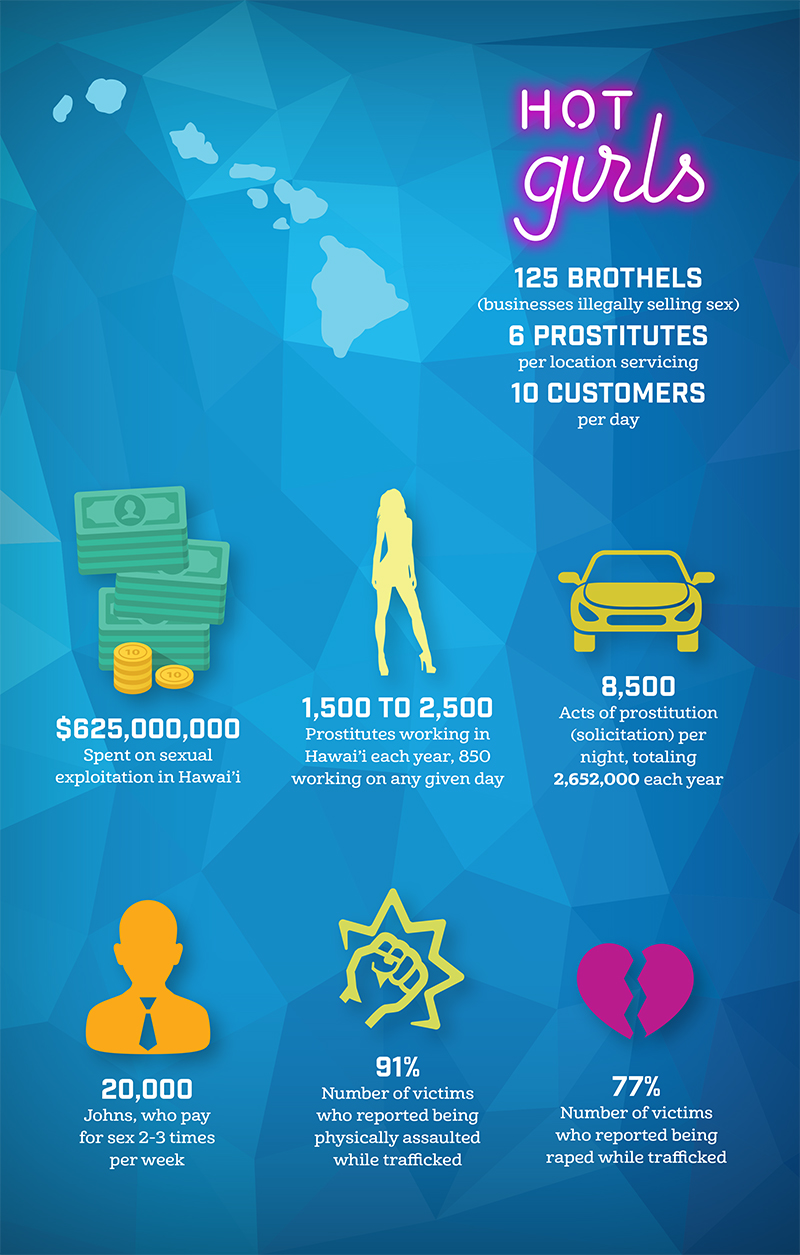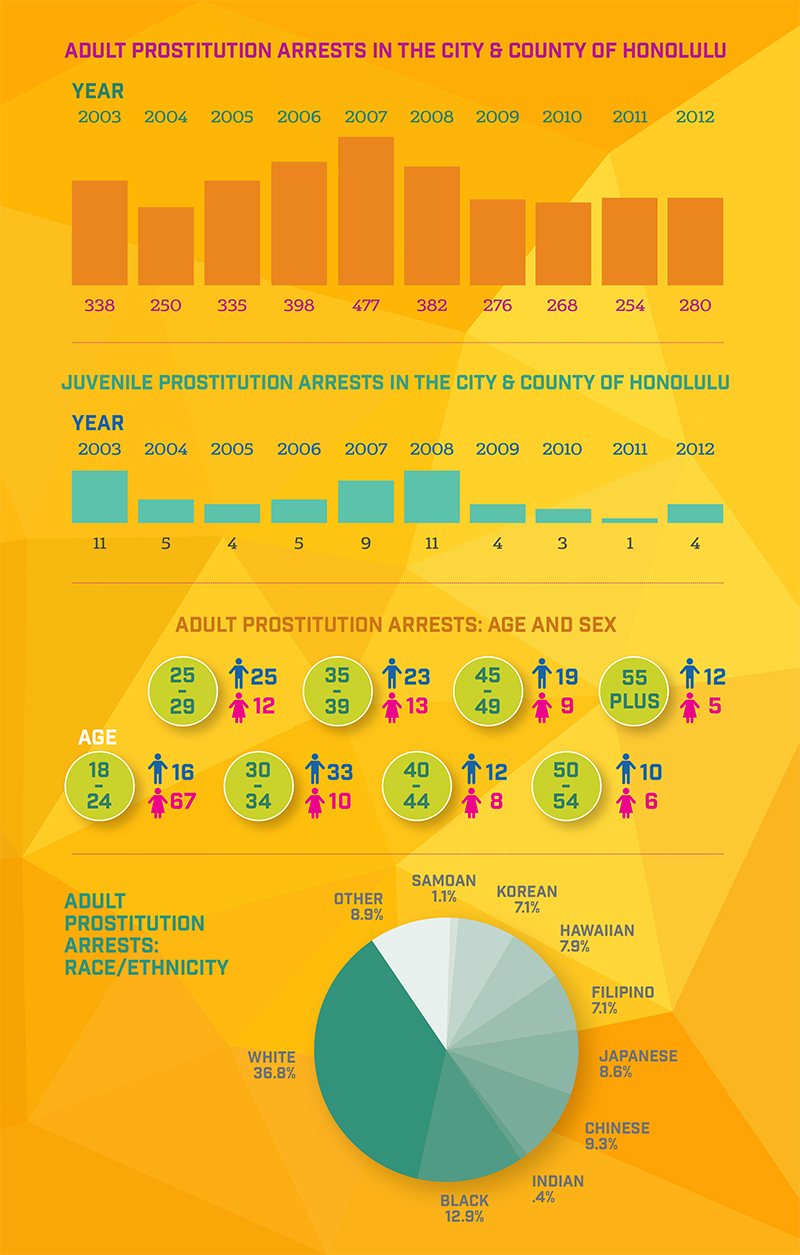Hawaii: sex trafficking hub of the Pacific
Prostitution is a major industry in Hawaii, but with no sex trafficking laws on the books, the victims involved in the industry have no protection and no easy way out.
In 2013, 8,174,460 visitors from all over the world traveled to Hawaii, contributing $14.52 billion to the tourism industry. But tourism isn’t the only booming industry in the state. Hawaii is also a hub for sex trafficking.
“The reference [people make] is always to sex trafficking. There is no crime called sex trafficking,” says Honolulu City Prosecutor Keith Kaneshiro. “The crime is prostitution, whether it’s … prostitutes being brought into the state, or prostitution within the state,”
Hawaii has no law against “sex trafficking.” Instead, individuals who traffic women are prosecuted under the “promoting prostitution” statute. Whether they are a pimp or a mamasan at a massage parlor, they do not face sex trafficking charges. In 2011, the state passed its first labor trafficking bill, HB 141 (which was signed into law as Act 146), but there has been no legislation passed to address sex trafficking.
According to federal law, pimp-controlled prostitution is considered sex trafficking. The “Victims of Trafficking and Violence Act of 2000,” defines sex trafficking as “the recruitment, harboring, transportation, provision, or obtaining of a person for the purpose of a commercial sex act.”
While pimp-controlled prostitution and sex trafficking are defined similarly, State Senator Suzanne Chun Oakland says the two terms have different consequences for prosecuting pimps.
“We don’t reference human trafficking, we still refer to people as prostituting,” Sen. Oakland says. “I think, to some extent, [referring to women as prostitutes] makes it more difficult to prosecute [johns] … In most other states, they would say it’s really mislabeling what’s going on.”
IMUAlliance Executive Director Kris Coffield says that many women who are arrested for prostitution are victims of sex trafficking, sexual abuse and/or coercion.
“The biggest problem with our prostitution code … is that it criminalizes both johns and victims,” Coffield says. “A lot of victims come from broken homes; homes where there’s domestic violence and places where they’ve been sexually assaulted.”
Coffield says that many women are coerced into working in the sex industry in their teens, while others need a way to make ends meet in the state with the highest cost of living in the country. But unfortunately, even those forced into the sex industry are criminalized by the Hawaii’s prostitution code.

Source: IMUAlliance | Graphic by Mae Ariola
A Paradigm Shift?
The traditional response by the Anaheim Police Department (APD) to women working in the sex industry had long been to arrest them and treat them as criminals. But in 2011, the department changed its policy toward prostitution arrests by considering prostitutes to be victims of human trafficking, according to a report by Steve Marcin of the FBI. The change in the department’s attitude toward women working in the industry has been called a “paradigm shift.”
“People see a pimp as someone who obtains customers for a prostitute,” Marcin wrote in the report. “The reality is that they use manipulation, threats and violence to keep these women from leaving … Out of fear or a desire to be cared for, hookers protect their pimps.”
In August 2011, APD started offering support services to women that had been arrested for prostitution. After an arrest was made, law enforcement would explain that the women had been victims of abuse, and that they were in a safe place. The women were encouraged to cooperate with police to build cases against their pimps while receiving counseling and other supportive services.
APD had arrested just three pimps between 2008 and 2011. During the first 14 months of the new initiative, 38 pimps had been arrested and charged. In those 14 months, 20 of the 38 pimps had been convicted while the remaining 18 were still awaiting trial.
“Most prostitutes recognize their actions as illegal; however, a substantial number of them truly are victims,” Marcin wrote in the report.

Source: IMUAlliance | Graphic by Mae Ariola
Prostitution arrests in Hawaii
An investigation by the Honolulu Civil Beat found that only one pimp was arrested each year in 2010 and 2011. The state of Hawaii’s Uniform Crime Report recorded that in 2012, there were only 280 prostitution-related arrests in Honolulu County, down from 477 arrests in 2007.
“We conservatively estimated that there are 125 establishments [that sell sex] in Hawaii, most of them in Honolulu,” Coffield says. Eighty of these establishments are located between Waikiki and Ward Avenue, he says.
According to a recent study by IMUAlliance, there are approximately 2,652,000 exchanges of sex for money in Hawaii each year. There are an estimated 850 unique sexual providers working at any given time, and between 1,500 to 2,500 providers in the state each year.
A person commits the crime of prostitution in Hawaii when they engage in, or make an agreement for, sexual conduct with another person for a fee. However, police can make an arrest even before an exchange of cash is made.
Penalties for engaging in prostitution in Hawaii are some of the most lenient in the country: the first offense of prostitution is a petty misdemeanor. Both “johns” and “providers” (the women offering sex) can be charged with the petty misdemeanor, which comes with a mandatory $500 fine and up to 30 days in jail or probation.
As a first offense in Alabama, the crime of prostitution is considered a misdemeanor, with up to one year in prison and/or a fine of $6000. An individual charged with prostitution in Indiana faces up to one year in prison and a $5000 fine.
In Hawaii, pimps are prosecuted under the statute of promoting prostitution. An offense in the first degree—in which a pimp forces a prostitute to have sex for money—carries a maximum sentence of 20 years in prison. Promoting prostitution in the second degree includes no coercion and can lead to a maximum sentence of 10 years.
Women may be eligible for a statewide witness protection program when testifying against a pimp who is charged with promoting prostitution, but there must be evidence of pimp-controlled prostitution for a witness to qualify for the program.
However, without testifying against her pimp, a woman working in the sex industry receives no legal protection, even if she is there against her will. Women who are arrested for prostitution-related charges are prosecuted to the same extent as johns.
“Right now because there’s no legal definition of sex trafficking, they’re not being identified as sex trafficking victims,” Coffield says.
As an advocate for victims of sex trafficking, Coffield says that it is necessary to redefine Hawaii’s prostitution code to prevent the criminalization of those forced into the sex industry.
“One of the best things that we can do, is to take the prostitution law and parse it into two: one that applies to johns, and a much lesser, differentiated, differently-named statute—if we have to have a law—that applies to what we believe to be our victim population,” Coffield says. “A lot of this is very common sense stuff.”
This feature is part 2 of a series of 4 articles covering sex trafficking in Hawaii.
